 |
|

|
 |
TABLE of CONTENTS
 |
Legislative session begins with several MnDOT proposals |
By Erik Rudeen, Government Affairs
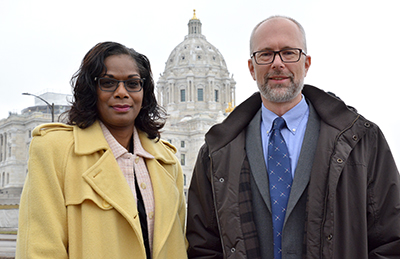
Terrina White, legislative assistant on mobility from Metro District contract administration, and Erik Rudeen, state legislative liaison, head to a hearing at the state Capitol. Photo by Rich Kemp |
The 2017 legislative session began on Jan. 3, as legislators were sworn in for a two-year session. MnDOT’s legislative agenda includes several policy initiatives. Here are a few highlights:
- Flaggers in work zones— allow a peace officer to issue a citation to the driver of a vehicle if the officer has probable cause to believe that the driver violated a flagger’s direction within the past four hours. If a flagger can report the violation to a peace officer and the driver could be cited afterwards, then there would be fewer violations.
- Drone registration — changes Minnesota Statutes Chapter 360 to more explicitly allow MnDOT to regulate unmanned aircraft systems, or drones, through a $25 annual registration. Current law requires a minimum $100 annual registration fee. Unmanned aircraft systems used for recreational purposes are exempt.
- Sponsorship of highway property — gives MnDOT the authority to enter into agreements with businesses, civic groups or individuals for the maintenance and improvement of trunk highway property. Examples include sponsoring plantings to enhance pollinator habitat, the Adopt A Highway program and highway beautification projects.
- Bicycles — updates several portions of Minnesota statutes that govern bicycle laws and repeal outdated Minnesota Rules. These statutes and rules were last updated in the 1970s. They have obsolete definitions and do not reflect current designs for safe bicycle facilities such as protected bike lanes. Also, this proposal designates a new bicycle route from St. Paul through Duluth and terminating at the Canadian border north of Grand Marais.
Gov. Mark Dayton announced his budget proposals, which include a sustainable transportation funding proposal, on Jan. 24. The governor proposes addressing the gap in road and bridge funding through:
- Imposing a 6.5 percent gross receipts tax on gasoline
- Increasing registration fees
- Authorizing $2 billion in trunk highway bonds over the next eight years
- Realizing MnDOT efficiencies
The governor’s budget also includes funding for transit, aeronautics, freight rail and passenger rail. For details, go to transportation operating budget and for details about the governor’s capital budget recommendations, go to transportation capital budget.
Weekly summaries of legislative hearings and introduction of transportation bills can be found on iHUB under the 2017 legislative session. |
 |
|

|
 |
TABLE of CONTENTS
 |
Public can view road conditions from snowplow cameras |
By Sue Roe
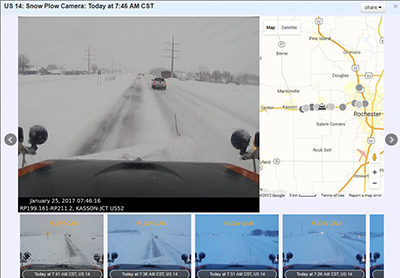
This is what the plow cams show on the 511 website. This image was taken Jan. 25 on Hwy 14 between Kasson and Rochester. |
The public can now view winter road conditions from MnDOT’s new “plow cams” available through the 511mn.org website. Some of the agency’s 838 snowplows are equipped with cameras that show real-time road conditions along plow routes. The new feature launched Jan. 25.
“The plow cams are another way for travelers to make good decisions about their travel plans during the snow and ice season,” said Kelly Braunig, 511 program manager. “If they go on the 511 site and see that travel is not advised, they can actually see an image of the road the cameras take as the plow is traveling. Seeing is believing.”
Travelers can already see road conditions on major highways from the Road Weather Information System, which is also part of 511. These are fixed cameras at 97 locations across the state that show live rotating photos. While the RWIS cameras show a small area of the road, the plow cams show real-time road conditions as snowplows plow their routes.
“The RWIS and plow cameras are both used for maintenance purposes, and the public also benefits,” said Steve Lund, state maintenance engineer. “They give maintenance managers and supervisors a quick snapshot of what’s going on in the field but the plow cams will show the road conditions from the driver’s seat along a route.”
The plow cams are available on the 511 website’s full-featured and streamlined pages and the 511 app. They are also available on the “Personalize Your 511” feature, which is on the full-featured and truckers’ pages.
To access the plow cams, go to www.511mn.org and click on “Plow Cameras” on the left menu. A window will open to show photos and a map where the plow is. Underneath the current photo and map is a “film strip,” showing images every five minutes. The camera will activate when the plow is going at least 10 miles per hour or based on other filtering criteria.
Photos have captions that give the plow number, the date, time and location of the plow. Images will be displayed for two hours. If a new image is not taken for 15 minutes because, for example, a snowplow has stopped to refuel, the snowplow icon will be removed from the map until the plow is active again.
The active trucks displayed on 511 only represent a portion of MnDOT’s fleet for snow and ice and other maintenance activities. Not all of the cameras are fully implemented in the trucks, but 200 cameras were purchased for this winter season. MnDOT is in the testing stage this season, which will allow the agency to make decisions on whether to install additional cameras.
“All the new features we’re putting on 511 come down to intelligent transportation,” said Braunig. “We want to be on the cutting edge of that. If motorists can just pick one or two features to use, they can make better travel decisions.”
For more information on other features of the 511 system go to www.511mn.org. |
 |
|

|
 |
TABLE of CONTENTS
 |
Commissioner Zelle signs pledge to join fight against human trafficking |
|
By Angela Forsythe, Office of Chief Counsel
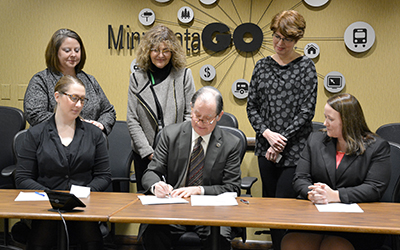
Clockwise from front left: Tara Kalar, associate legal counsel; Tracy Hatch, deputy commissioner, chief financial officer and chief operating officer; Christy Bailly, Metro Transit, Caroline Palmer, Minnesota Coalition Against Sexual Assault and Angela Forsythe, associate legal counsel, look on as Commissioner Charlie Zelle signs a pledge Jan. 17 for Transportation Leaders Against Human Trafficking on behalf of all MnDOT employees. Photo by Judy Jacobs |
On Jan. 17, Commissioner Charlie Zelle signed a pledge for Transportation Leaders Against Human Trafficking on behalf of all MnDOT employees, signaling the agency had joined the fight against human trafficking.
MnDOT has committed to this pledge by:
- Taking a formal stand against human trafficking
- Educating employees on how to recognize and report signs of human trafficking
- Raise awareness among the traveling public on human trafficking issues
- Share resources and key data points with other anti-trafficking organizations.
MnDOT, with the support of its leadership, takes this pledge seriously and has already taken steps to make good on these commitments:
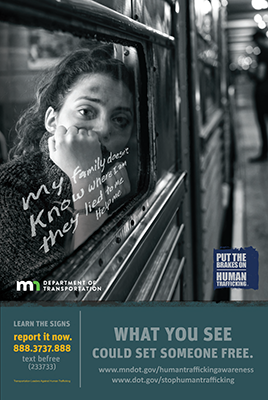
MnDOT joined in the partnership with transportation stakeholders across the country in combating human trafficking. |
Pledge 1: Take a Formal Stand against Human Trafficking
Prior to signing the Transportation Leaders Against Human Trafficking Pledge, Zelle addressed the severity of the human trafficking crisis and outlined MnDOT’s role in eradicating the human trafficking trade.
“MnDOT is an agency in a unique position to adversely affect the flow of human trafficking in Minnesota due to its oversight of transportation by land, air and water," Zelle said "Removing the ease of transport is a step toward ending human trafficking.”
Pledge 2: Educate Employees
This spring, MnDOT will roll out mandatory training for both its agency employees and third party employees who work at MnDOT facilities and on MnDOT property. This training, required for all agency employees, is a short web-based training focused on recognizing and reporting signs of human trafficking in society. Details will follow.
Pledge 3: Raise Awareness
Beginning this spring, all Minnesota rest areas will display human trafficking awareness posters to help educate and inform the almost 20,000 visitors that use rest areas across the state each year. Each of these posters will include the toll-free hotline to report suspected human trafficking. These posters are available for viewing and download at the MnDOT Human Trafficking Awareness resources website.
Pledge 4: Share Resources and Data
MnDOT has formed several collaborative relationships to fight against human trafficking. MnDOT will be a member of the Minnesota Human Trafficking Task Force, with deputy commissioner Tracy Hatch acting as the Commissioner’s delegate. MnDOT has also formed relationships with organizations such as the Minnesota Department of Health, Truckers against Trafficking and the U.S. Department of Human Services Blue Campaign. These relationships will be a source of information and resource sharing moving forward. Tara Kalar and Angi Forsythe, both from the Office of Chief Counsel, will serve as liaisons and points of contact for this program.
To learn more about human trafficking and MnDOT’s role in the fight against it, contact Angela Forsythe, associate legal counsel, at angela.forsythe@state.mn.us, or Tara Kalar, associate legal counsel, at tara.kalar@state.mn.us. |
 |
|

|
 |
TABLE of CONTENTS
 |
Maintenance staff use multiple strategies to treat winter roads |
By Sue Roe
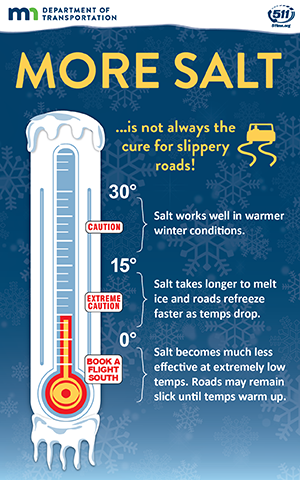
This graphic explains how salt works during temperature variations. |
MnDOT uses several strategies and materials to provide safe winter road conditions for the traveling public. Rock salt, or sodium chloride, is the main and most effective, low-cost ingredient in nearly all those strategies.
MnDOT uses salt to make brine, which is basically liquid salt, made up of mostly water with a 23 percent salt solution. Brine is used in anti-icing, de-icing and pre-wetting, MnDOT’s three main strategies to treat roads.
Anti-icing is used before a winter event to prevent the formation of frost and the bonding between snow and ice and the pavement. This helps plows scrape off compacted ice and snow easier.
Anti-icing can reduces the amount of time required to restore the roads to the desired level of service, which can mean savings in materials, staff and equipment.
De-icing is done during and after the weather event has occurred. De-icers chemically break the bond between ice and pavement. They improve the ability for plows to clear compacted ice and snow from the roadways. De-icing is often performed in conjunction with plowing.
Last winter season, MnDOT used 174,000 tons of salt, more than any other material, to clear roads.
Pre-wetting is another technique that involves treating de-icing salt with salt brine to help jump-start the melting process because salt has to be dissolved to melt snow and ice. Pre-wetting also helps salt stick to the pavement better. Because more salt stays in the travel lanes, pre-wetting can lessen the impact on the environment by reducing salt and sand use.
“People always ask why we just can’t use more salt when roads get difficult to drive on,” said Kathy Schaefer, who trains snowplow operators on the use of chemicals. “The answer really lies in the timing of winter events and current conditions, such as air and surface temperatures. When we have sub-zero temps, chemicals don’t work very effectively.”
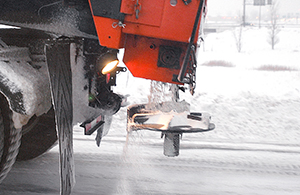
A snowplow distributes salt during a winter storm.
Photo by David Gonzalez |
Salt works by lowering the freezing point of water and is most effective when used in pavement temperatures above 15 degrees.
At temperatures colder than 15 degrees, the cutoff for straight salt applications, there isn’t enough moisture present for salt to dissolve and melt ice. That’s when alternative chemicals such as calcium chloride and magnesium chloride are used. These chlorides have different properties, including how they attract moisture. Chemically speaking, they have two chloride ions, compared to one in sodium chloride, which makes them effective in colder temperatures.
Calcium and magnesium chlorides are used in pre-wetting to jump-start the melting process. They are also used to pre-treat salt piles and, in lesser amounts to keep the salt from freezing. These products contain organic materials such as sugar beet juice or corn syrup. The organic component serves as a corrosion inhibitor and is sticky, which can help the material stick in the salt pile and on the road. MnDOT does not generally use organics as stand-alone products.
Whatever form of salt used, its effectiveness is directly related to the surface temperature of a snow- or ice-covered road. One pound of salt can melt 46 pounds of ice at 30 degrees but only 8.6 pounds at 15 degrees.
Several others factors, including humidity levels, dew point temperatures, type and rate of precipitation, timing of the application and road surface type, are all considered when determining what method will work best.
While chemicals effectively melt ice and snow, sand is used to provide traction but it only works temporarily since it is quickly displaced by traffic. Sand alone doesn’t melt snow and ice. It’s combined with salt to keep it workable or mixed with a liquid de-icing chemical just before spreading so the sand embeds into the ice covered pavement.
Sand is most often used in very cold temperatures when chemicals lose their effectiveness. It’s applied at hazardous driving locations such as curves, intersections, railroad crossings and inclines.
Last winter, MnDOT used 32,000 tons of sand on state roadways. |
 |
|

|
 |
TABLE of CONTENTS
 |
Newly funded studies tackle transportation problems |
|
By Shannon Fiecke, Research Services & Library
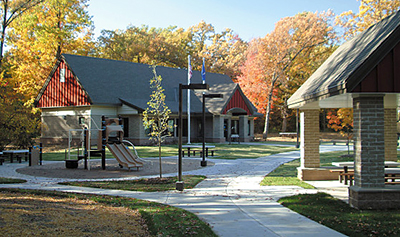
MnDOT buildings produce wastewater that is either discharged to a local wastewater treatment facility or managed through a combination of septic systems and holding tanks. A new research study will investigate the potential for treating and reusing wastewater at MnDOT safety rest areas and truck stations to reduce water consumption and minimize the discharge of contaminants into the sewer system. Photo courtesy of Paulsen Architects |
Can Twin Cities roadsides be used to grow habitat for endangered bumble bees? Are unseen factors affecting safety at rural intersections? How should Minnesota transportation agencies prepare for connected vehicle technology?
Minnesota’s next round of transportation research projects will attempt to solve these and other questions facing the state’s transportation community. The Transportation Research and Investment Group, which governs MnDOT’s research program, and the Minnesota Local Road Research Board, which represents cities and counties, recently selected 21 transportation research projects for funding in fiscal year 2018.
A couple of MnDOT’s more notable projects will evaluate the reuse of wastewater at safety rest areas and truck stations and develop a system to optimize the location of 80 truck stations due for replacement in the next 20 years. MnDOT will also partner with the Local Road Research Board to evaluate the use of personal warning sensors for road construction workers.
In addition to the problem of stripping underneath sealcoats on some city streets, top research studies for local governments involve pedestrian safety enforcement and investigating whether rural, low-volume roads should be treated differently than urban roads for storm water runoff. Current regulations govern runoff the same, regardless of daily vehicle count or surrounding land use.
“The selected research studies, which typically take one to three years to complete, will address some of the most major policy, environmental and maintenance dilemmas facing transportation practitioners,” said Linda Taylor, Research Services & Library director.
Find the complete list of funding awards here.
Feb. 10 Deadline for Submitting Ideas for Research Implementation
Want to put a new technology or method into practice in your work area? MnDOT is currently accepting research implementation ideas for its FY2018 funding cycle. Funding is available for demonstration projects that will help offices or districts solve problems, save money or change business practices. Consult the implementation project guidelines and submit ideas by Feb. 10 using IdeaScale. |
|
 |
|

|
 |
TABLE of CONTENTS
 |
Materials Lab's William Loher eligible for vacation donation |
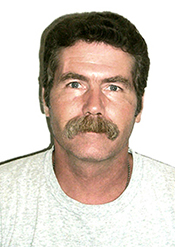
William Loher, Office of Materials and Road Research, was diagnosed with congestive heart failure and is eligible for the vacation donation program. Photo courtesy of the Office of Materials and Road Research |
William Loher, geotechnical engineering section crew supervisor in the Office of Materials and Road Research, is now eligible for the state vacation donation program.
Loher has been diagnosed with congestive heart failure with significantly reduced pump function of his heart. As a result, he is deconditioned, weak and has an extremely limited function for activity.
He has exhausted all of his sick and vacation leave. Employees may donate up to 40 hours of vacation to help Loher. However, donations in any amount will be helpful.
Curt Pape, transportation program supervisor senior in the Office of Maintenance, is also eligible for the vacation donation program. Check out his story in previous Newsline.
To donate vacation hours, go to the Employee Self Service Web site and click “Other Payroll” and then “Leave Donations.” The site also allows employees to view a list of all state employees eligible for the program and to enroll as a recipient.
|
 |
|

|
 |
TABLE of CONTENTS
 |
Improve Intentional Customer Engagement baseline survey update |
By AnneMarie Burgess, WIG coaching program manager
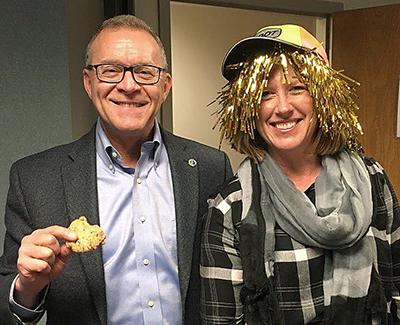
Scott McBride, Metro District transportation engineer, and Janet Cheney, Metro District Business Operations and Services Office manager, show off the Golden WIG traveling trophy. Congrats to Metro District Business Operations and Services for receiving the biggest increase in survey responses during the December push. Photo by Jocelyn Stein |
We are excited to share the feedback collected during the customer survey as we continue our efforts to measure and improve our customer engagement. Survey results will be sent to offices and districts later this week.
Your work group’s WIG sessions are a great opportunity to discuss as a team how to best use the survey results. Remember: these baseline measures are a point-in-time and serve as a place to start or from which to build. Internal resources are being developed to assist work groups that want to create more product- or work area-specific customer measurements.
When reviewing the survey results, please consider how and where these baseline measurements may be used to refine your current or future sub-WIG as the “A” (baseline) measure. Remember, teams have selected a sub-WIG because it is viewed as the most effective way for their local work group to improve customer engagement.
In our day-today activities, work groups should ask:
- Do we know what our customers want?
- Do we consider the impact of our work on customers?
- Do we provide products and services that are easy to use and understand?
- Can we find ways to delight our customers?
Our focus is to grow customer engagement and ultimately customer trust by improving MnDOT's:
- Customer involvement
- Impact to our customers
- Customer experience
On Jan. 23, Deputy Commissioners Tracy Hatch and Sue Mulvihill sent an email to all staff sharing the new A to B statements (lag measures) for the customer goal and focus area. These goal statements have also been added to the WIG 2.0 framework on iHub so you can simply click on each box within the diagram to view them. Analysis on the feedback continues, so watch for future updates as our work evolves. |
 |
|

|
 |
TABLE of CONTENTS
 |
Office of Equity and Diversity kick-off monthly e-news |
By Judy Jacobs
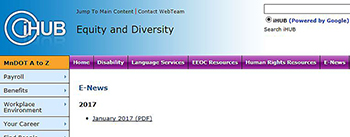
Office of Diversity & Inclusionís enews can be found on their iHUB page. |
The Office of Diversity & Inclusion Newsletter launched last week. Each month the newsletter will capture MnDOT diversity initiatives, training and events in the districts and throughout the divisions.
In last week’s inaugural issue, the Office of Diversity and Equity team members were highlighted with services and assistance each provides, along with individual contact information. Team members have experience and expertise in the areas of discrimination complaint investigation, mediation services, training opportunities, language and interpretive services, reasonable accommodations, hiring process monitoring as well as eight Employee Resource Groups designed to mentor and promote professional development and help advance MnDOT’s diversity and inclusion core.
In the inaugural edition of the newsletter, Commissioner Charlie Zelle said, “MnDOT is deeply committed to expanding our intercultural competence and diversifying our workforce to effectively deliver high-quality, dependable transportation systems, compete for a highly skilled workforce, gain trust in the communities we serve and create a work environment where all employees feel valued and be able to contribute their best. Being an effective, diverse and inclusive organization is not only the right thing to do, it is also essential to MnDOT’s core value of diversity and inclusion.”
The newsletter will be sent via NoteMailer each month to MnDOT employees.
Please share this publication with others who may be interested and encourage them to register through GovDelivery for future editions of the newsletter. |
 |
|

|
 |
TABLE of CONTENTS
 |
Whatís new on the web |
eDOCS links on iHUB
As you may know, there are many links on iHUB that go to documents stored in MnDOT’s Electronic Document Management System, or eDOCS. This system uses software to store, organize and retrieve electronic documents, and to maintain document versions and a historical record of creation, edits and use.
Recently, the tool used to link to eDOCS from iHUB was updated, causing many of the old links to break. While most of those old links have been swapped out with the new link, it’s possible there are still a few old links floating around out there. If you spot any eDOCS links that aren’t working, or that look like this example, please contact the Communications Office web team at webteam.dot@state.mn.us and let us know so we can help you fix. |
 |
|

|
 |
TABLE of CONTENTS
 |
Agency receives AASHTO Safety Leadership Award |
By Sue Roe MnDOT received a 2016 AASHTO Safety Leadership Award at the association’s annual meeting in Boston in November. Commissioner Charlie Zelle accepted the award on behalf of the agency.
The award, submitted by Office of Traffic Safety and Technology, recognizes states that made significant improvements by showing leadership in safety, strong safety partnerships and strategic planning, and safety innovation.
"The OTST and districts have long been testing and implementing innovative solutions and initiatives,” said Sue Mulvihill, deputy commissioner and chief engineer. “Their efforts are key in helping us improve safety on Minnesota's transportation system. Congratulations go out to OTST and the districts for their work."
The award was based on MnDOT’s efforts to improve roadway safety, including:
- The Strategic Highway Safety Plan and safety plans at the district and county levels that help prioritize and fund projects.
- The Toward Zero Deaths program and the coalitions the state and regional coordinators have built to use resources and assess crash risks.
- New alternative intersection designs such as roundabouts, reduced conflict intersections and diverging diamonds that help the state reduce injury crashes and fatalities.
- An Intelligent Work Zone System that includes zipper merge, speed warning systems and queue warning systems.
- Mumble strips that improve safety and reduce exterior noise to residents.
“Winning this award shows the great safety commitment that MnDOT dedicates at the district and central office levels and through the Toward Zero Deaths program,” said Jay Hietpas, state traffic engineer.
AASHTO’s award announcement cited MnDOT for using “multidisciplinary approaches to eliminate fatalities and life-changing injuries that come from roadway crashes. MnDOT is willing to try new safety countermeasures and methods for moving toward zero deaths.”
The Tennessee Department of Transportation also received a Safety Leadership Award.

Members of the Office of Traffic Safety and Technology team are, from left: Peter Buchen, Ken Johnson, Jay Hietpas, Kelly Franco, Sue Zarling, Rashmi Brewer, Heather Lott, Eric Davis, Kristine Hernandez, Ron Bisek, Sue Mulvihill, Jeff Morey, LouAnn Naatz, Rick Sunstrom, Jolene Servatius, Jerry Kotzenmacher, Julie Whitcher, Sue Sheehan, Derek Leuer, Lesa Monroe, Diane Colton, Janelle Anderson and John Peters. Photo courtesy of the Office of Traffic Safety and Technology |
|
 |
|

|
 |
TABLE of CONTENTS
 |
Employees recognized for their work with race, equity |
By Rich Kemp
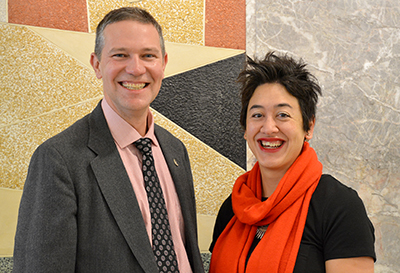
Eric Davis, chief of staff, and Sarah Rudolf, statewide public engagement coordinator, are assisting with the Government Alliance for Race and Equity. Photo by Rich Kemp |
Eric Davis, chief of staff, and Sarah Rudolf, statewide public engagement coordinator, were recently recognized for their work with the Government Alliance for Race and Equity.
GARE is based on pioneering work done in Seattle, Wash., to address systemic inequities within city services. It is now a national network of city, county and state agencies working to achieve racial equity and advance opportunities for all.
Davis and Rudolf joined a team of 20 employees from across state agencies, as well as more than a dozen Minnesota cities, for a one-year GARE learning cohort. Minnesota is one of the first states to participate in the program.
“Government programs weren’t always created to serve everyone,” said Rudolf. “GARE recognizes this and is working to recalibrate the way things are done.”
Rudolf serves as the team leader for the state government’s participation with GARE. She meets with James Burroughs, the state’s chief inclusion officer, and representatives from several state agencies to address Minnesota’s racial disparities. |
 |
|

|
 |
TABLE of CONTENTS
 |
Transportation funding, advancing equity, improving customer engagement top MnDOTís goals for 2017 |
By Commissioner Charlie Zelle
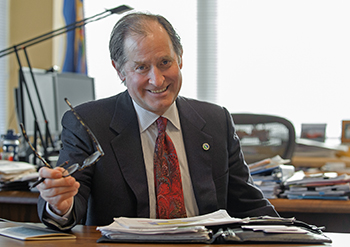
Commissioner Charlie Zelle discusses MnDOTís goals for 2017. Photo by David Gonzalez |
As 2017 gets started, I want to take some time to talk about MnDOT’s goals for the coming year. At the end of last year, we submitted our accomplishments for 2016 to the Governor’s office and provided our goals for 2017. The overall goal areas are Transportation Funding, Advancing Equity, and Improve Intentional Customer Engagement. You will find more detail on these goals below.
It is important for MnDOT to evaluate and set goals each year. The work that we do is incredibly important and very complex. We are entrusted with significant amounts of funding each year, and with the responsibility for maintaining Minnesota’s transportation system.
We have a significant effect on Minnesota’s economy. Manufacturing and agriculture rely on a good transportation system to receive raw materials and get their goods and crops to market. Employers rely on a sound transportation system that allows their employees to get to and from work safely and reliably. And, our state’s tourism industry relies on good roads and bridges that will bring millions of visitors to Minnesota each year to enjoy our beautiful state.
We also face great complexity in what we do. Building roads and bridges requires good engineering that ensures that the roads and bridges are safe for travel and will last for as long as possible. We manage different types of funding from different sources. Each has its own requirements that we need to meet in a timely fashion. We have to plan 20 years out, 10 years out and four years out. We have to look to the future and anticipate what the needs may be, and then develop plans to meet those needs. We have to consider technology, innovations, societal changes and even climate change as we look to the future.
And, we need to be prepared for the changes society will make in the future. We have to think about our workforce and how to best plan for the inevitable change of generations. MnDOT is working hard on advancing diversity because society is becoming more diverse. We need to be a work place that is attractive to all and that mirrors the society that we serve.
This is critical because as employees retire, we need to attract new employees to fill vacant spaces. If we are not perceived as a workplace that embraces diversity and accepts all, we will face a significant challenge in hiring new talent. And I believe that a diverse workforce will be strong because of the many talents that diverse candidates will bring to MnDOT.
While these are high-level goals, we all need to think about where we fit in each of these goals. The work we do every day will help the agency make progress. It is important for each of you to see how what you do fits in with each of these goals. Your work every day has an effect on how we are doing and the progress we are making. You are part of the engine that makes MnDOT move forward. If you aren’t sure, talk with your supervisors and managers.
As we move into the New Year, I want to say thanks for your efforts last year, and for the great things you will do in 2017. I often tell others at national meetings about MnDOT’s strong, professional workforce. I feel fortunate to be able to say I am part of this team.
MnDOT 2017 Goals
Transportation funding
- Continue effort to secure long-term transportation funding package to meet the $18 billion gap over the next 20 years between revenue forecast to come in and anticipated needs to maintain the transportation system
Advancing equity
- Meet agency goals in the Disadvantaged Business Enterprise program contract awards, Targeted Group Businesses and Veterans owned businesses
- Meet workforce goals for contractors on state projects
- Meet Certified Small Businesses goals for general and maintenance procurement contracts
- Develop a five-year Strategic Operating Plan that will translate our vision, mission, core values and long-range transportation system plans into near-term operational priorities linked to specific actions. The Strategic Operating Plan will support outcomes, measures of success and actions organized under six goals: customer engagement, equity, financial effectiveness, resiliency, IT and data management, and workforce excellence.
- Work as part of a state multi-agency subcabinet to improve the lives of people with disabilities via the Olmstead Plan. MnDOT transportation goals in the plan include:
- By Dec. 31, 2020, make accessibility improvements to 4,200 curb ramps (increase from base of 19 percent to 38 percent) and 250 accessible pedestrian signals (increase from base of 10 percent to 50 percent.)
- By 2025, increase the annual number of transit passenger trips to 17 million, and service hours to 1.7 million in Greater Minnesota (approximately 40 percent increase).
- By 2025, expand transit coverage so that 90 percent of the public transportation service areas in Minnesota will meet minimum service guidelines for access.
- By 2025, improve transit systems' on-time performance to 90 percent or better statewide.
Improving intentional customer engagement
- Earn trust and increase transparency by becoming a customer-centered organization that engages customers, listens to understand and balances the diverse needs of all to achieve the best outcomes
- Survey internal and external customers to help develop plans to improve customer engagement in the coming year
|
 |
|
| |
|



